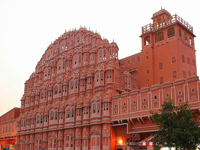Place to visit in Jaipur
Hawa Mahal Hawa Mahal, is a palace in Jaipur, India. It was built in 1799 by Maharaja Sawai Pratap Singh, and designed by Lal Chand Ustad in the form of the crown of Krishna, the Hindu god. Its unique five-storey exterior is also akin to the honeycomb of the beehive with its 953 small windows called jharokhas that are decorated with intricate latticework. The original intention of the lattice was to allow royal ladies to observe everyday life in the street below without being seen, since they had to observe strict "purdah" (face cover). |
 |
||
Built of red and pink sandstone, the palace is situated on the main thoroughfare in the heart of Jaipur's business centre. It forms part of the City Palace, and extends to the Zenana or women's chambers, the chambers of the harem. It is particularly striking when viewed early in the morning, lit with the golden light of sunrise. |
|||
|
|||
these. It has been inscribed on the World Heritage List as "an expression of the astronomical skills and cosmological concepts of the court of a scholarly prince at the end of the Mughal period". The observatory consists of fourteen major geometric devices for measuring time, predicting eclipses, tracking stars' location as the earth orbits around the sun, ascertaining the declinations of planets, and determining the celestial altitudes and related ephemerides. Each is a fixed and focused tool. The Samrat Yantra, the largest instrument, is 90 feet (27 m) high, its shadow carefully plotted to tell the time of day. Its face is angled at 27 degrees, the latitude of Jaipur. The Hindu chhatri (small cupola) on top is used as a platform for announcing eclipses and the arrival of monsoons. |
|||
Jal Mahal Jal Mahal (meaning "Water Palace") is a palace located in the middle of the Man Sagar Lake in Jaipur city, the capital of the state of Rajasthan, India. The palace and the lake around it were renovated and enlarged in the 18th century by Maharaja Jai Singh II of Amber. "The Jal Mahal palace has got an eye-popping makeover. Traditional boat-makers from Vrindavan have crafted the Rajput style wooden boats. A gentle splashing of oars on the clear lake waters takes you to Jal Mahal. You move past decorated hallways and chambers on the first floor to climb all the way up to the fragrant Chameli Bagh. Across the lake, you can view the Aravalli hills, dotted with temples and ancient forts, and on the other side, bustling Jaipur. |
 |
||


